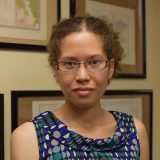J'Nese Williams
Imperial Plans and Local Governance:
The St. Vincent Botanic Garden, 1765–1822
In the late 18th and early 19th centuries, the British government began funding botanic gardens in its colonies to manage economic and scientific botany projects. Though these gardens were an overall success, the St. Vincent Botanic Garden struggled to fulfill its mission. As an example of failure, the history of the St. Vincent Garden reveals the limitations of government support of science in this period.
J’Nese Williams, Vanderbilt University
Her dissertation research, The Texture of Empire: British Colonial Botanic Gardens and the Uses of Science in the Late Eighteenth and Early Nineteenth Centuries, adopts a local view to demonstrate how British colonial governments, botanic gardens, and private organizations and individuals collaborated to produce and implement plant policy before the centralization of imperial governance.



 Location LuEsther T. Mertz Library
Location LuEsther T. Mertz Library